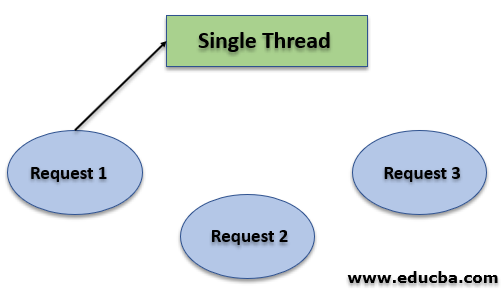Updated March 20, 2023

Introduction to Node.js
Node.js is an open-source runtime environment that uses JavaScript on the server-side. It is based on Google Chrome’s V8 engine and runs on various platforms such as Windows, Linux, Mac, etc. Node.js uses asynchronous programming. It is used for building highly scalable, data-intensive web applications. Building such web applications requires frameworks. This framework is a collection of tools, helpers, and libraries. The popular frameworks built for this are Express.js, Sails.js, AdonisJs, Meteor.js, Nest.js, Koa.js, LoopBack.js, Hapi.js, Derby.js, and Total.js.
Why Use Node.js?
While there are multiple frameworks that come with some benefits, Node.js is the one that takes over development in enterprises. The multiple features that Node.js offers such as event-driven and asynchronous programming. Also, it uses a single thread to operate the requests.
Features of Node.js
Given below are the features mentioned:
1. Single-threaded
Node.js operates on a single thread. It is based on the “Single Threaded Event Loop Model” architecture which can handle multiple client requests. The main event loop is executed by a single thread, but in the background, the input-output work is performed on separate threads; as Node.js is asynchronous. Event Loop is what allows the node.js to perform all the non-blocking operations.
2. Asynchronous
Node.js is asynchronous by default, i.e it operates in a non-blocking way. Meaning, when a client requests to a server, a single thread handles the request; it checks if the request involves any database interaction if it does not; the request is processed and the server sends back the response to the client. The thread is ready to handle the next request.
3. Event-driven
The event-driven concept is similar to the concept of the callback function in asynchronous programming. The only difference is that the callback function executes once the asynchronous function returns its result and events are triggered on its associated event handler.
4. Performance
Node.js is built on Google Chrome’s V8 JavaScript engine, which helps us in faster code execution. The engine compiles the JavaScript code into machine code which makes our code easier and faster to implement in an effective manner. Concepts like asynchronous programming and the way it operates on nonblocking input-output operations make its performance high. Node.js uses events highly which makes it pretty fast.
5. Highly Scalable
The applications are highly scalable as they operate in an asynchronous (non-blocking) way. It works on a single thread, when a single request arrives, starts processing it, and is ready to handle the next request. Also, once the response is prepared, it is sent back to the client.
6. Node Package Manager(NPM)
As we are familiar with, the Node Package Manager is a package manager for the Node JavaScript runtime environment and is a recommended feature of the Node.js installer. It is the world’s largest online repository. For all the above features that Node.js provides, it is preferred more in the development of enterprise industries.
Working of Node.js
It uses asynchronous programming.
Let us have a look at how it works:
1. A single thread in Node.js handles all the incoming requests.
2. A client sends a request to the server.
3. A single thread is allocated to handle the request.
4. The thread then checks if the request requires querying the database or any complex operations, the thread does not wait for the database to return the data, instead, the thread is ready to serve another request.
5. Meanwhile, for the first request which involves interaction with the database, the thread places that particular request in the Event Queue.
6. Event Queue operates on a single thread only.
7. When a request is placed in the Event Queue, it starts processing that particular client request.
8. It then checks the availability of thread in the Internal Thread Pool. Internal Thread Pool consists of multiple threads.
9. A thread is then assigned to look after the request, which takes the request forward, processes it, prepares the response and sends it back to the Event Loop.
10. The event loop, in turn, sends the response back to the client.
11. When the next request arrives, it again checks if that current request requires to query the database, if not then the thread takes the request ahead, processes it, and sends back the response to the client.
Thus the above scenario explains how Node.js handles concurrent client’s requests and operates on a single thread and does not need the creation of multiple threads. It uses fewer threads so that it can use fewer resources. Also, this example explains that this is asynchronous by default, event-driven, and operates in a non-blocking way.
Real-time Examples of Node.js
Given below are the real-time examples:
1. Netflix: Netflix is a streaming service and has a large number of consumers.
2. PayPal: PayPal is an online payment platform and has over 200 million active user accounts.
3. Uber: Uber is a platform that connects cab drivers to customers. Because of its nature of processing large amounts of data and convenient error analysis, it was chosen as the backend technology.
4. LinkedIn: LinkedIn is a professional networking site. It is the main technology that supports the backend of the LinkedIn app. LinkedIn serves as business and service employment-oriented services.
5. Walmart: Walmart is the world’s largest retail chain.
6. eBay: eBay is a multinational e-commerce function. The developers wanted to make the application real-time.
Conclusion
Thus we overlooked the reasons why Node.js is chosen as the technology for the development of web applications and looked at the real-time examples of Node.js. We also went through the working of Node.js.
Recommended Articles
This is a guide to Why Use Node.js. Here we discuss the introduction, features, working and real-time examples of Node.js. You may also look at the following articles to learn more –




